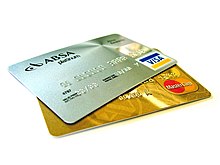Electronic funds transfer
Electronic funds transfer or EFT refers to the computer-based systems used to perform financial transactions electronically.
The term is used for a number of different concepts:
- cardholder-initiated transactions, where a cardholder makes use of a payment card
- electronic payments by businesses, including salary payments
- electronic check (or cheque) clearing
Card-based EFT

EFT may be initiated by a cardholder when a payment card such as a credit card or debit card is used. This may take place at an automated teller machine (ATM) or point of sale (EFTPOS), or when the card is not present, which covers cards used for mail order, telephone order and internet purchases.
Card-based EFT transactions are often covered by the ISO 8583 standard.
Transaction types
A number of transaction types may be performed, including the following:
- Sale: where the cardholder pays for goods or service.
- Refund: where a merchant refunds an earlier payment made by a cardholder.
- Withdrawal: the cardholder withdraws funds from their account, e.g. from an ATM. The term Cash Advance may also be used, typically when the funds are advanced by a merchant rather than at an ATM.
- Deposit: where a cardholder deposits funds to their own account (typically at an ATM).
- Cashback: where a cardholder withdraws funds from their own account at the same time as making a purchase.
- Inter-account transfer: transferring funds between linked accounts belonging to the same cardholder
- Payment: transferring funds to a third party account
- Inquiry: a transaction without financial impact, for instance balance inquiry, available funds inquiry, linked accounts inquiry, or request for a statement of recent transactions on the account.
- Administrative: this covers a variety of non-financial transactions including PIN change.
The transaction types offered depend on the terminal. An ATM would offer different transactions from a POS terminal, for instance.
Authorization
EFT transactions require communication between a number of parties. When a card is used at a merchant or ATM, the transaction is first routed to an acquirer, then through a number of networks to the issuer where the cardholder's account is held.
A transaction may be authorized offline by any of these entities through a stand-in agreement. Stand-in authorization may be used when a communication link is not available, or simply to save communication cost or time. Stand-in is subject to the transaction amount being below agreed limits. These limits are calculated based on the risk of authorizing a transaction offline, and thus vary between merchants and card types. Offline transactions may be subject to other security checks such as checking the card number against a 'hotcard' (stolen card) list, velocity checks (limiting the number of offline transactions allowed by a cardholder) and random online authorization.
A transaction may be authorized via a pre-authorization step, where the merchant requests the issuer to reserve an amount on the cardholder's account for a specific time, followed by completion, where the merchant requests an amount blocked earlier with a pre-authorization. This transaction flow in two steps is often used in businesses such as hotels and car rental where the final amount is not known, and the pre-authorization is made based on an estimated amount. Completion may form part of a settlement process, typically performed at the end of the day when the day's completed transactions are submitted.
Authentication
EFT transactions may be accompanied by methods to authenticate the card and the card holder. The merchant may manually verify the card holder's signature, or the card holder's Personal identification number (PIN) may be sent online in an encrypted form for validation by the card issuer. Other information may be included in the transaction, some of which is not visible to the card holder (for instance magnetic stripe data), and some of which may be requested from the card holder (for instance the card holder's address or the CVV2 value printed on the card).
EMV cards are smartcard-based payment cards, where the smartcard technology allows for a number of enhanced authentication measures.
See also
- MAPESA : Blog specialised on money transfer, remittances and cards issues www.mapesa.org
- Debit card
- Wire transfer
- Automated Clearing House
